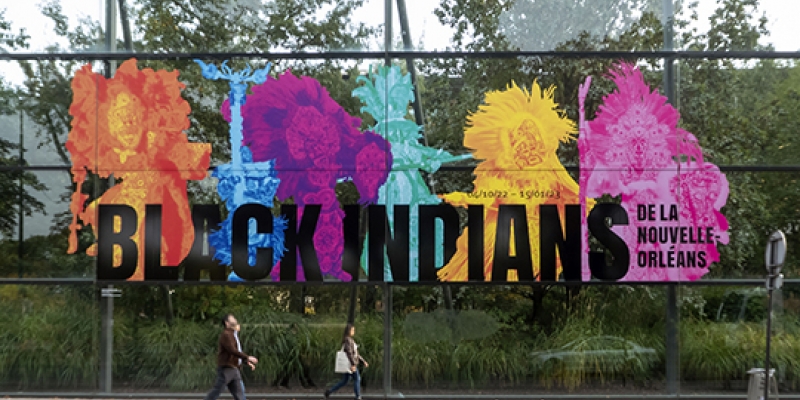
Thursday, October 6th, 2022
Black Indians of New Orleans
Cover image: Black Indians signage at Musée du quai Branly - Jacques Chirac
© Entrée to Black Paris
I was intrigued when I first heard about the Black Indians de la Nouvelle-Orléans exhibition at the Musée du quai Branly - Jacques Chirac and excited when I received an invitation to attend the October 3 vernissage (opening). I had no preconceived notions about what I would see there, and I was anxious to find out how the museum would present this subject.
Visitors to the exhibition first encounter an enormous Indian "suit" - a traditional Black Indian garment - displayed to the right of a video that introduces Big Chief Darryl Montana, the son of one of the most influential chiefs of the Black Indian tribes (note that these are not Indian nations, such as the Choctaw, Coushatta, and Chitimacha tribes of Louisiana). I found this to be a marvelous prelude, and my appetite was whetted for what I thought would be an exhibition full of information about the history and customs of the Black Indian (aka Mardi Gras Indian) tribes and how they have interrelated throughout the years.
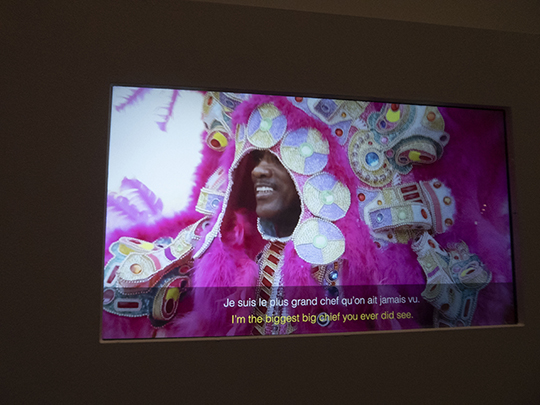
Big Chief Darryl Montana - video
© Entrée to Black Paris
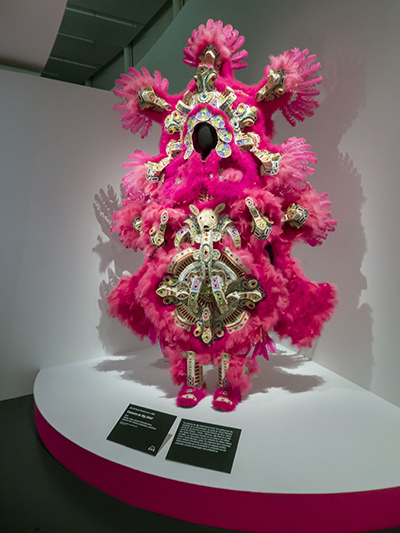
Big Chief Costume
Big Chief Darryl Montana
2015 Textiles, ribbons, dyed ostrich feathers,
glass beads, sequins and cabochons, rubber
© Entrée to Black Paris
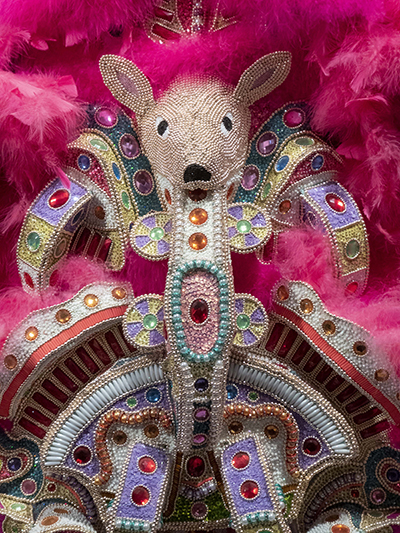
Big Chief Costume - detail
© Entrée to Black Paris
If you visit this exhibition, you should understand that this is not what you will find in the show.
When you pass the initial installation and enter the exhibition space, you will be plunged into the world of the indigenous populations of what is now the U.S. and the history of the colonial exploits of France and Spain as they claimed lands for their sovereigns. You will learn that Europeans first enslaved indigenous peoples and then turned to Africa for the labor they needed to establish their colonies and maintain the revenues generated from them. You will encounter installations that present the transatlantic slave trade, including artifacts and video that describe and demonstrate the conditions that captives endured during the Middle Passage.
Information panels and accompanying installations describe how New Orleans became the largest slave market in North America and how enslaved Africans and indigenous people were able to interact freely during Sunday sessions at Congo Square. One panel indicates that the first feathered costumes that foretold the emergence of the Black Indians were worn at the square.
From this point on - because of the title of the exhibition - I thought the remainder of the show would delve into the history of the indigenous tribes in southern Louisiana, the origins of the enslaved Africans who were brought to the area, and how the two groups intermingled. This history is the basis upon which the masking culture of today's Black Indians is built.
I also thought there would be an in-depth presentation on the evolution of the Black Indian tradition in Louisiana throughout the centuries.
Instead, the show continues to trace the history of the area through a European colonial lens and then examines the Civil War and post-Civil War race relations in the American South as a whole, including Jim Crow, the Ku Klux Klan, the Civil Rights Movement, and modern-day racism during the Trump administration.
Only three panels specifically address race relations in Louisiana.
Magnificent suits are installed in various rooms along the path through the exhibition. I had the good fortune to encounter Big Chief Dow Michael Edwards, a retired New Orleans attorney who created two of them. I overheard him chatting with one of the museum guides about the suit he named The Taking. It is a magnificent feat of craftsmanship, and the imagery sewn into the garment tells the story of Europeans capturing Africans and Native Americans to force them into slavery.
_Big Chief Dow Michael Edwards_front_2019_400px wide.jpg)
The Taking (front)
Big Chief Dow Michael Edwards
2019 Ostrich, goose, and duck feathers, cowhide,
crocodile skin, beads, rhinestones, and shells
© Entrée to Black Paris
_Big Chief Dow Michael Edwards_rear_2019_400px wide.jpg)
The Taking (rear)
© Entrée to Black Paris
Big Chief Edwards graciously posed for a photo and then went on to attract a crowd as he continued to talk about his work.
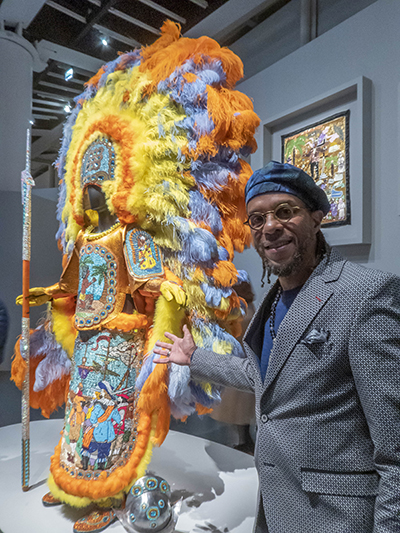
Big Chief Dow Michael Edwards and The Taking
© Entrée to Black Paris
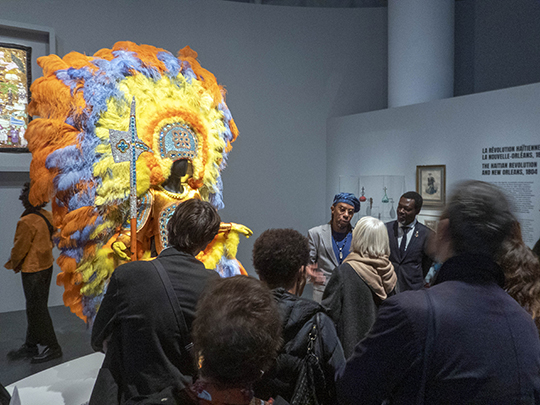
Big Chief Dow Michael Edwards addresses the crowd
© Entrée to Black Paris
As one might expect, Black Indians is an exhibition built around objects. Yet the curator has included several pieces of fine art in the show. As an example, two works from Michael Ray Charles' Forever Free series hang in this part of the show - The Road Most Traveled and Facts of Live.
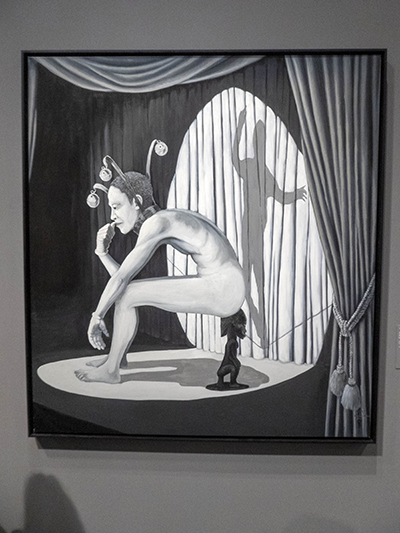 Forever Free - The Road Most Travelled
Forever Free - The Road Most Travelled
Michael Ray Charles
2013 Acrylic and penny copper on canvas
Private Collection
© Entrée to Black Paris
Attention is refocused on Louisiana about three quarters of the way through the exhibition, when visitors can view a 6m27s video called "Black Indians - Origines." This is somewhat of a rehash of what has already been presented in the show. You then walk past the enormous and powerful painting by Mexican-American artist Vincent Valdez called The City I, which depicts Klan men, women, and even a baby, at a rally on terrain above an unidentified city, to arrive at an installation on Hurricane Katrina and the devastation it wreaked on the African-American citizens of New Orleans.
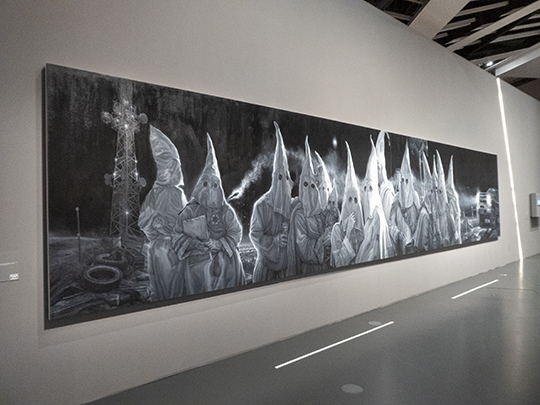 The City I
The City I
Vincent Valdez
2015-2016 Oil on canvas
Blanton Museum of Art
Austin, TX
© Entrée to Black Paris
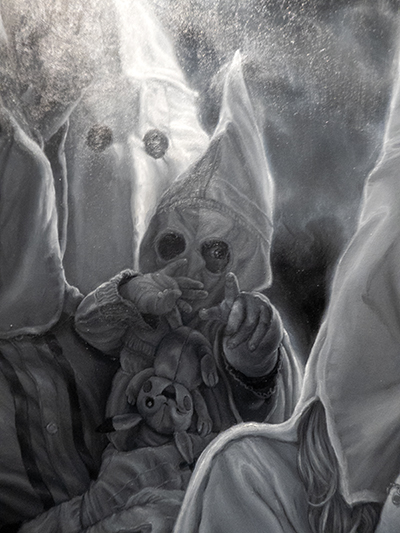 The City I - detail
The City I - detail
Vincent Valdez
2015-2016 Oil on canvas
Blanton Museum of Art
Austin, TX
© Entrée to Black Paris
An information panel in this section presents New Orleans' Social Aid and Pleasure Clubs, which have a 130+ year tradition of providing assistance for black people in New Orleans when white insurance companies would not serve them. A video presents a 2+ minute interview with Big Chief Victor Harris regarding this somber period in New Orleans history. One of Chief Harris' suits is displayed next to the video.
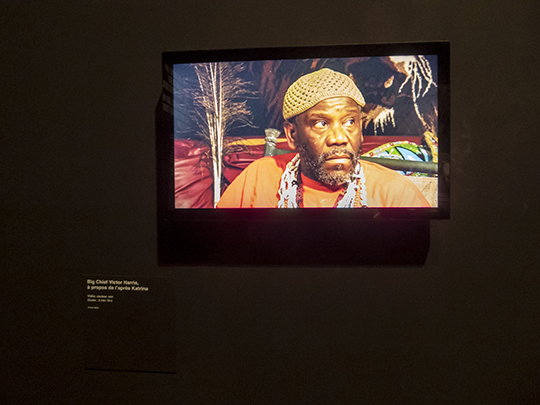 Big Chief Victor Harris - video
Big Chief Victor Harris - video
© Entrée to Black Paris
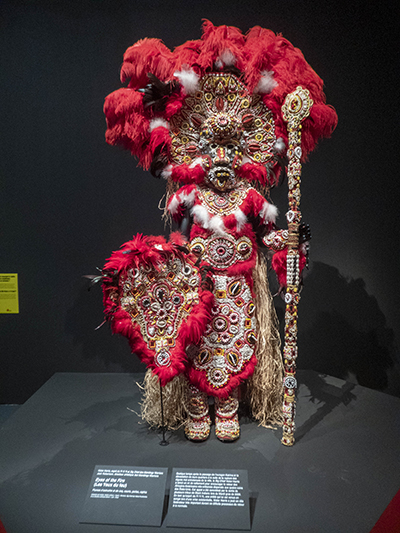 Eyes of the Fire
Eyes of the Fire
Big Chief Victor Harris
Ostrich and rooster feathers, cowrie shells, pearls, raphia
Collection of the artist
© Entrée to Black Paris
Next is an area where you can view a 7m29s video called "Black Indians - Aujourd'hui," which consists of vignettes of interviews with contemporary Black Indians.
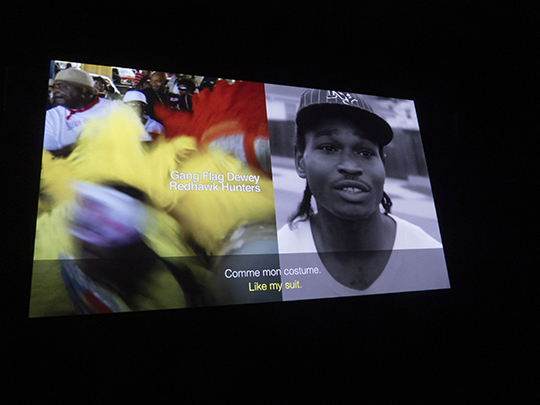 Gang Flag Dewey of the Redhawk Hungers
Gang Flag Dewey of the Redhawk Hungers
in "Black Indians - Aujourd'hui" video
© Entrée to Black Paris
After watching this video, you enter the last room of the exhibition, which is filled with garments worn by Black Indians in parades held during Mardi Gras. There are also display cases containing objects from the museum's collection that evoke the origins of some of the traditions held by today's Black Indians. Several information panels provide information that I believe should have been introduced and expanded upon much earlier in the exhibition.
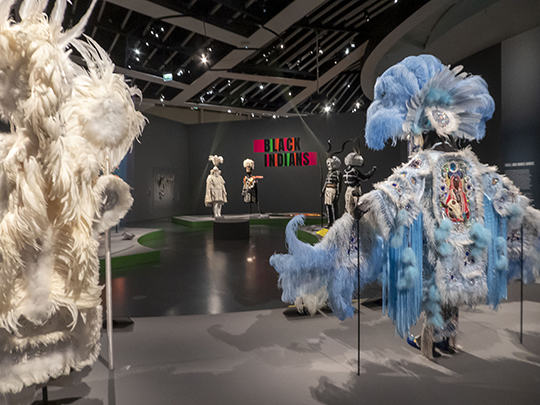 Final room of Black Indians exhibition - 1
Final room of Black Indians exhibition - 1
© Entrée to Black Paris
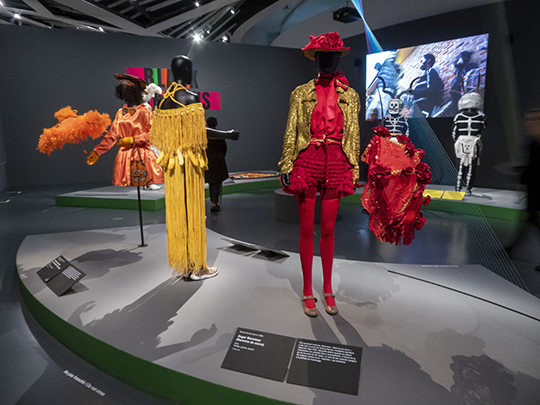 Baby Dolls suits
Baby Dolls suits
© Entrée to Black Paris
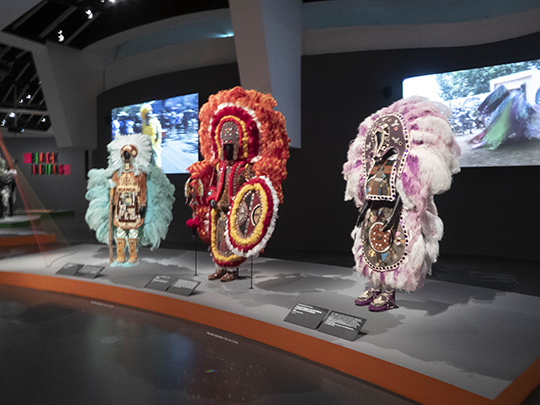 Final room of Black Indians exhibition - 2
Final room of Black Indians exhibition - 2
© Entrée to Black Paris
Black Indians de la Nouvelle-Orléans is visually and informationally exquisite. The artisanship and the passion that went into the creation of the suits on display is phenomenal and the information presented is intricately detailed. But I feel that the exhibition does not present nearly enough information about the Black Indians to warrant its name.
Black Indians de la Nouvelle-Orléans
October 4, 2022 - January 15, 2023
Tuesday, Wednesday, Friday, Saturday, Sunday - 10:30 AM - 9:00 PM
Thursday - 10:30 AM - 10 PM
Entry: 12€
Reduced price entry: 9€
Musée du quai Branly - Jacques Chirac
37, quai Branly
75007 Paris
Metro: Bir Hakeim (Line 6), Ecole Militaire (Line 8), Alma-Marceau or Iéna (Line 9)
RER C: Pont de l'Alma or Champs de Mars Tour Eiffel
For information about the Black Indians of New Orleans, visit the following links:
Black History Month: Celebrating Iko Iko, Mardi Gras Indians, and the Second Line
Mardi Gras Indians Begin Carnival by Honoring "Big Chief Tootie Montana," the "Chief of Chiefs"
Super Sunday 2019: The history behind Mardi Gras Indian Tradition and Culture
Mardi Gras Indians History and Tradition
The Evolution of Tradition: A Mardi Gras Indian Queen Shows Off a New Type of Suit

 Our Walk: Black History in and around the Luxembourg Garden - Click here to book!
Our Walk: Black History in and around the Luxembourg Garden - Click here to book!